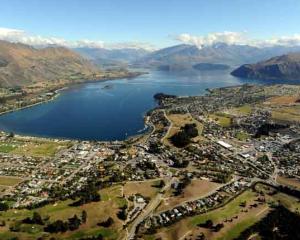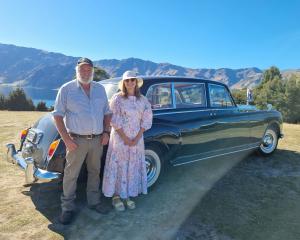
The outbreak of the Covid-19 pandemic might have pushed back new developments for air travel to the Queenstown Lakes district, but the plans have not gone away.
The Queenstown Airport Corporation wants to expand noise boundaries at Frankton and develop Wanaka Airport for commercial jets, and Christchurch International Airport wants to develop a new, competing, airport on farmland at Tarras.


Is there justification for three transtasman-capable airports — at Queenstown, Wanaka and Tarras?
Singleton: Tarras and Queenstown airports can co-exist. Realistically, Tarras and Wanaka are alternatives. The site and location of Tarras means it can provide optimal connectivity for much longer.
Keel: We don’t believe so. There are already four established airports within a one-three hour drive of each other and well positioned across the lower South Island — Dunedin, Invercargill, Queenstown and Wanaka — with capacity to together serve the social and economic needs of their communities for decades to come. The proposal to build a large-scale, long-haul jet-capable international airport in a small rural town situated in a unique environment like Tarras is at odds with what we are hearing from communities across the region regarding the responsible management of future air services growth and sustainable tourism.
What would be the best arrangement for air travel to this region once tourism growth patterns return to pre-Covid-19 levels?
Singleton: Building at a new site enables us to create an airport Central Otago can be proud of. Our project would enable more sustainable aviation, be able to cater for future generations and serve a wider area.
Keel: Please see the answer to the above question.
How urgent are decisions on the future of airport infrastructure in this region, given the pause created by Covid-19?
Singleton: Covid-19 has lessened the urgency of the issue, but it takes time to create good infrastructure that works well for the community and environment. This is why we believe now is the time to plan ahead through exploring the potential of an airport on our site.
Keel: The slowdown created by Covid-19 has created an important opportunity to reset and consider the future we all want for the region and to plan accordingly. We have time to take a considered and balanced approach to infrastructure development, including airport infrastructure. Community consultation and input is key to this process.
What rough timeline should airport development be following?
Singleton: The key thing for us, in these uncertain times, is not the timeline — it’s the process. It’s important we get this right. That is why we are starting by meeting with locals, industry, iwi and other stakeholders. We want to hear their thinking, what concerns them most and what opportunities they want this project to consider. These are critical conversations. If we decide an airport on our site is viable, listening now will help us create a formal proposal that addresses as many concerns, and creates as many opportunities, as possible.
Keel: We have considered this in our current statement of intent: QAC halted its master planning work for both Queenstown and Wanaka airports in 2019 at the request of QLDC while they undertook their independent impact assessments and the district spatial plan work. More recently the timeline for restarting the master-planning process has been impacted by Covid-19 and the resulting reduction in regional aviation activity. As and when this planning work recommences, QAC will need to revisit its previous long-term forecasts to ensure that they align with the district spatial plan as well as the broader outlook for air transport in the post-Covid-19 environment.
Ultimately, QAC’s long-term planning will be interconnected with QLDC’s long-term planning, forecasts and aspirations for the district. [abridged]
Does central government being a minor shareholder in Christchurch International Airport Ltd mean it endorses CIAL’s Tarras proposal?
Singleton: CIAL is an independent commercial entity governed by an independent board. The board endorses our strategy and talks to each of our shareholders. We will continue our discussions across government and respect the confidentiality of those discussions.
Keel: Not necessarily.
What part could/should central government be playing in decisions over airport infrastructure in this region?
Singleton: Central government has a number of roles to play, including as transport and infrastructure policy maker and regulator.
Keel: Both central and local governments have a role to play. Central government is actively addressing nation-building infrastructure through the Infrastructure Commission and its shovel-ready programme. It is also engaged in the district spatial planning process with [the Queenstown Lakes District Council] and Kai Tahu, which seeks to establish a blueprint for future sustainable growth in the Queenstown Lakes and adjacent areas. It is important that such nationally significant decisions regarding air connectivity and infrastructure in the region are carefully made and are informed by this work.
Does CIAL have the QAC over a barrel in that Tarras has, it seems, greater scope for development — particularly in terms of runway length?
Singleton: We don’t see it like that. We think Tarras is an attractive option because of its scope and deserves to be considered as a long-term solution for the region’s airport needs.
Keel: Bigger isn’t necessarily better. The very clear message from those in this region and nationally is that it is critical to focus on high-value, sustainable tourism, rather than high volumes, and the protection of our unique and beautiful place. A new large-scale international airport in this region would fly in the face of that message.
Has any thought been given to a joint venture between the QAC and CIAL at either Tarras or Wanaka?
Singleton: We have an open mind and an open door to conversations with other parties including QAC and QLDC.
Keel: QAC has two committed and supportive shareholders in its majority shareholder Queenstown Lakes District Council (75.01%) and minority shareholder Auckland International Airport (24.99%). QAC and its shareholders are of the view that the region is well-served by its existing airports now and into the future.
Is there anything else?
Singleton: We agree Covid-19 is giving us all time to plan for future demand in the lower South Island. However, it’s important we make the most of this time to have conversations with communities and continue planning.
Keel: We expect at some point in the future to resume the long-term planning process for Wanaka Airport. In any event, and to ensure clarity on a specific point raised in recent public commentary, QAC has not sought nor is it seeking going forward to accommodate wide-body jet operations in the long-term planning for Wanaka Airport.












